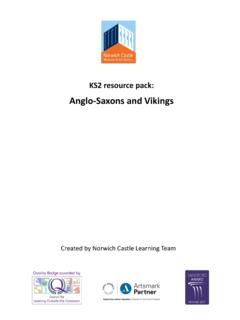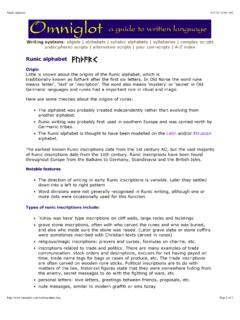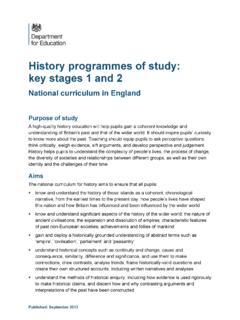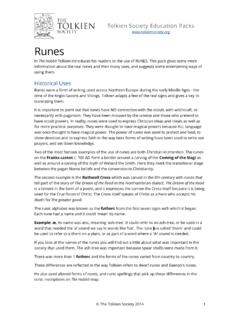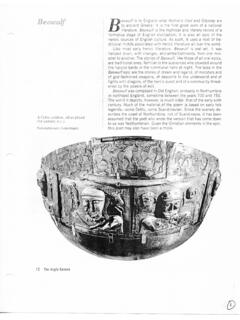Transcription of An Outline of British History - Steven L. Rosen
1 1 An Outline of British History By Steven L. Rosen , 2 MAIN PERIODS IN British History STONE AGE BRITAIN (5000 BC- 55BC) THE CELTS (800-600 BC- Roman occupation) ROMAN BRITAIN (55BC- AD 440) ANGLO- saxon AND VIKING PERIOD (440-1066) EARLY MIDDLE AGES (1066-1290) LATER MIDDLE AGES (1290-1485 THE TUDOR AGE (1485-1603) THE STUARTS(1603-1714) GEORGIAN ENGLAND (1714-1837) THE VICTORIAN AGE (1837- MODERN BRITAIN (2 Oth Century-) 3 The Beginnings of British History : Stone Age Britain Over thousands of years, groups of people came from the continent of Europe to Britain. The very first people were Stone Age hunters living all over Europe and the British Isles. It was about 2400 BC when the first farmers arrived in England from southern Europe; these are the people who built the mysterious stone monuments like Stonehenge. Then, about 1700 BC another group of taller and stronger invaders who used metal tools came from Holland and Germany.))
2 Like all the groups who invaded Britain throughout its early History , they married and mixed in with the native population. Stonehenge 4 The Celts The Celts came to England about 800 BC from Central Europe (France and Germany). Another group of warlike Celts invaded in the 4th century BC and conquered land in the north of England and Scotland and Ireland. They became the first aristocracy to control most of Britain. They imposed their language (Gaelic) on the people, which still survives today to some degree in Ireland and Scotland and Wales. The Romans After the Celts, the next group of people to come to Britain and rule over it was the Romans. The Romans first came in 55 and 54 BC. They lived peacefully in England for about 300 years. The brought to Britain a highly developed legal system, system of taxation, engineering skills, Roman architecture and the Latin language. In the 4th century Rome was converted to Christianity and Christian missionaries went to Britain to spread that religion.
3 We sometimes call talk about this period as the Celtic-Roman period because the two different cultures lived together peacefully. In the 4th century AD, during the period of the collapse of the Roman Empire, the Roman troops in Britain left. Some historians say the Romans were important in British History , others say that their influence was really very small. In any case, after the Romans left, the Celtic people who remained were then invaded by a new group of people who had a very big influence on British History : the Anglo-Saxons. 5 The Anglo-Saxons After the Romans left England in the 4th century, the peaceful Celtic Britons were attacked by the warlike Angles, Saxons and Jutes, three groups of people who came from West Germany and Denmark. They took control of most of the country they called, Aengla-land between AD 450 and 600. They were an agricultural people who lived in long houses and spoke a language we now call Old English, which is, of course, a Germanic language.
4 The Vikings The Vikings came from Scandinavia. They were similar to the Anglo-Saxons, but more aggressive and warlike. Their Scandinavian language (Old Norse) was also Germanic so that was relatively easy for them to communicate with the Anglo-Saxons who had come from Germany and Denmark years before. When Vikings attacked in their long boats, the Anglo-Saxons united under King Alfred the Great (872-901) to try to fight them off. King Alfred is called The Great because he kept part of England free from Viking control. The Danish Vikings controlled the east northeast by the 9th century; the Saxons were able to maintain control in the west. 6 7 The Middle-Ages in British History (1066-1485) Key facts: England was ruled by the Norman French. The country was united under a feudal system. Great castles, cathedrals and monasteries were built. England went to war with France over land and lost.
5 The Norman French rulers gradually became English. The language of the people gradually changed into what we call Middle English. England went to war with Scotland and lost. The Black Death (plague) killed off almost half the population. 8 The Normans In October 1066 William, the Norman king invaded England, becoming King William I (William the Conqueror) of England. Within five years, the Normans had conquered all of England. They imposed unity on England and helped to link England with the culture of the rest of Europe. William gave a lot of land to the Norman nobility (known as barons). These barons then owed military service to the king. The nobility gave land to others to work on as farmers. People in the village who received land had to work 2 or 3 days a week on the rich person s land or pay taxes. This system of land holding is known as feudalism. The French invaders became the upper-class aristocracy who ruled over the English.
6 French was the language of the upper classes, of law and government and the army. The Anglo- saxon peasants did not speak French. The Normans built many castles which helped them to rule the land they had conquered. They also built beautiful churches in the shape of a cross. The arches above the doorways were always rounded (Romanesque style). They build fine monasteries which became the center of village life. The Rise of the English Nation By the 13th century, the rulers of England thought of themselves as English, not French. The rulers eventually spoke English like everyone else, not French. English and French had mixed over the years and evolved into what we now call Middle English. This period was a time of great changes in government 9and society. Oxford and Cambridge universities started in the 13th century. Also the power of a Parliament started growing in this period. Edward I (1272-1307) was a strong king who tried to take Scotland- but failed (because of brave Scotsmen like William Wallace and Robert Bruce).
7 Then in (1348-9) the Black Death (plague) came to England killing almost half the population. The Tudor Age (1485-1603): Renaissance, Reformation and a New World The social and economic order of the medieval period was beginning to break down. More and more people were rejecting the authority of kings and the Catholic Church. This was the period of the English Renaissance, and the growth of a new form of Christianity which rejected the authority of the Roman Catholic Church: Protestantism. The two most famous English monarchs in this period were Henry VIII and Elizabeth I of the House of Tudor. Henry VIII (1509-1547) 10 Henry VIII was a typical Renaissance prince: a poet, musician, fine horseman and lover of the arts. When he was 36, he still had no son and became tired of his Spanish wife Catherine of Aragon. He loved Anne Boleyn and asked the Pope permission to divorce Catherine so he could marry Anne. The Pope said no, and Henry broke with Rome.
8 There was a lot of anti-Catholic feeling in England so Parliament and the people supported Henry against the Pope. Anne Boleyn Parliament made the king the Supreme Head of the Church of England, and helped him to destroy the Catholic Church. Henry took church lands and buildings and gave much of the wealth to his friends. He ordered that church services should be 11in English instead of Latin and that each church should have an English bible. Queen Elizabeth I (1558-1603) Henry s first daughter, Mary, was Catholic like her mother Catherine, and tried to bring Catholicism back to England. However, when she died, the next in line was Henry s second daughter Elizabeth (by Henry s second wife, Ann Boleyn). She came to be queen at age 25. She was fluent in Greek, Latin, French, and Italian. She studied theology and became a strong Protestant. When she came to power England had no army or police and a weak bureaucracy.
9 When she died in 1603, she left England as one of the most powerful nations on earth. In 1559 Elizabeth made Protestantism as the national 12religion by having Parliament pass the Act of Supremacy: this law made the queen (or king) the supreme head of the Church of England. There were rumors that Catholics were going to try to assassinate Elizabeth and that Mary, Queen of Scots was involved. Parliament wanted her executed and Elizabeth had her head cut off (in 1587). King Philip of Spain wanted to help the Catholics in England (this was a time of fighting between Catholics and Protestants). Also, English and Spanish ships were coming into conflict on the ocean. By the mid 1580 s it became clear that Spain and England would go to war with each other. In one of the most famous battles in English History , the English beat the whole Spanish fleet in the English Channel (1588). In this same year Shakespeare arrived in London.
10 He wrote 20 plays which Elizabeth enjoyed very much. Many of his historical plays celebrated England s greatness. This was a time of great economic growth for England. This was also the beginning of the great age of exploration and discovery around the world. Great Elizabethan Playwrite 13 The English Civil War Under Elizabeth, the power of Parliament was growing. After she died, her cousin, king of Scotland, became King James I of England (1603). This was the end of the Tudor dynasty and the beginning of the House of Stuart. At this time, there were religious reformers who thought the Anglican Church (Church of England) was not strict enough and they wanted to reform it. These groups of religious reformers were called Puritans, because they wanted to purify the church. There was a lot of hostility towards these Puritans and some escaped England to make a new religious community, first in Holland, and then later in America (in Massachusetts).

